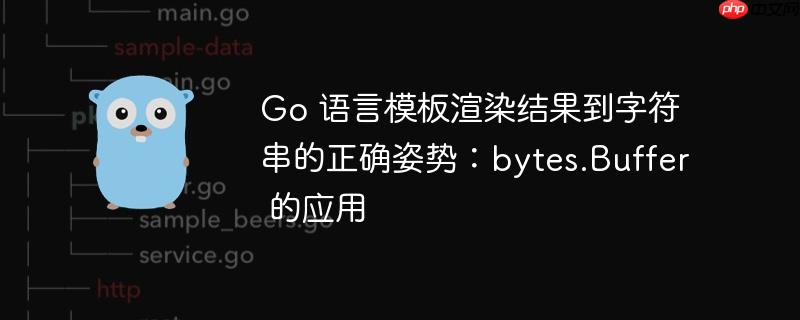
在 go 语言的 web 开发或文本处理场景中,我们经常需要使用模板引擎(如 html/template 或 text/template)来动态生成内容。通常,这些内容会直接写入 http.responsewriter 返回给客户端。然而,在某些特定场景下,我们可能需要将模板渲染的最终结果捕获为一个字符串,而不是直接输出:
Go 模板引擎的 Execute 方法需要一个 io.Writer 接口作为参数,所有渲染的内容都会通过这个 Writer 写入。因此,要将渲染结果捕获为字符串,关键在于提供一个能够将写入数据累积起来的 io.Writer 实现。
一些初学者可能会尝试自定义一个类型来实现 io.Writer 接口,以便捕获模板渲染结果。以下是一个常见的错误示例:
package main
import (
"fmt"
"os"
"html/template" // 使用 html/template 更符合 Web 开发场景
)
// 错误的 ByteSlice 实现
type ByteSlice []byte
func (p *ByteSlice) Write(data []byte) (length int, err error) { // os.Error 已废弃,应使用 error
*p = data // 错误:这里是赋值,而不是追加
return len(data), nil
}
func main() {
page := map[string]string{"Title": "Test Text"}
// 假设 test.html 存在且内容如下:
// <html><body><h1>{{.Title|html}}</h1></body></html>
tpl, err := template.ParseFiles("test.html")
if err != nil {
fmt.Println("Error parsing template:", err)
return
}
var b ByteSlice
err = tpl.Execute(&b, &page) // Execute 方法可能多次调用 Write
if err != nil {
fmt.Println("Error executing template:", err)
return
}
fmt.Printf(`"html":%s`, b)
}配套的 test.html 文件:
<html>
<body>
<h1>{{.Title|html}}</h1>
</body>
</html>运行上述代码,你会发现输出结果并非完整的 HTML,而是类似 "html":
以上就是Go 语言模板渲染结果到字符串的正确姿势:bytes.Buffer 的应用的详细内容,更多请关注php中文网其它相关文章!

每个人都需要一台速度更快、更稳定的 PC。随着时间的推移,垃圾文件、旧注册表数据和不必要的后台进程会占用资源并降低性能。幸运的是,许多工具可以让 Windows 保持平稳运行。

Copyright 2014-2025 //m.sbmmt.com/ All Rights Reserved | php.cn | 湘ICP备2023035733号